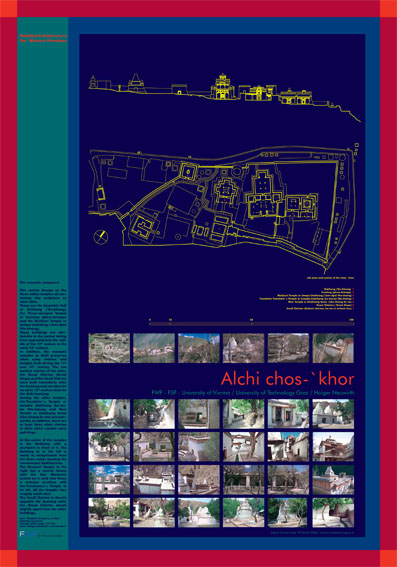
The
monastic compound
This section focuses on
the three oldest temples all con-taining clay sculptures as main idols.
These are the Assembly Hall or Dukhang (’Du-khang), the Three-storeyed
Temple or Sumtseg (gSum-brtsegs) and the Mañjusri Temple or Jampa
Lhakhang (’Jam-dpal lHa-khang).
These buildings are attributable to the period dating from approximately
the mid-dle of the 12th century to the early 13th century.
In addition, the monastic complex at Alchi preserves other early chörten
and temples built during the 13th and 14th century. The two earliest
chörten of the latter, the Great Chörten (Great Stupa) and
the Small Chörten were built immediatly after the Sumtseg and corroborate
an early 13th-century date for the Alchi Sumsteg.
Among the other temples, the Translator`s Temple or
Lotsaba Lhakhang (Lo-tsà-ba lHa-khang) and New Temple or Lhakhang
Soma (Lha-khang So-ma) are noteworthy. In addition, there are at least
three other chörten in Alchi which contain early paintings.
At the centre of the complex
is the Dukhang with a courtyard in front of it. The Sumtseg to to the
left is easily to recognizable from the
three niches housing the monumental Bodhisattvas. The Manjusri Temple
to the right has a central throne with the four Manjusris seated on
it, and now forms a common structure with the Translatore`s Temple
to
its left. All the temples face roughly south-east. The Small Chörten
is directly opposite the Sumtseg while the Great Chörten stands
slightly apart from the other buildings.
Text: “Buddhist Sculpture
in Clay”, Christian Luczanits, Chicago
2004
Fotos: Holger Neuwirth / Carmen Auer